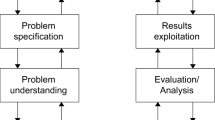Abstract
In recent days, the Government and other organizations are focusing on providing better health care to people. Understanding the patients experience of care-received is key for providing better health care. With prevailing usage of social media applications, patients are expressing their experience over social media. This patient authored text is a free-unstructured data which is available over social media in large chunks. To extract the sentiments from this huge data, a domain-specific dictionary is required to get better accuracy. The proposed approach defines a new domain-specific dictionary and uses this in sentiment scoring to enhance the overall sentiment classification on patient authored text. We conducted experiments on the proposed approach using NHS Choices dataset and compared it with popular classifiers like linear regression, stochastic gradient descent, dictionary-based approaches: VADER and AFINN. The results prove that the proposed approach is an effective strategy for sentiment analysis over patient authored text which helps in improving the classification accuracy.









Similar content being viewed by others
References
Bishop T (2016) NHS choices. https://doi.org/10.7748/phc.21.2.12.s16. https://data.gov.uk/dataset/73740ffe-cecb-4cba-afb9-51ea996187a1/nhs-england-nhs-choices-hospitals-patient-comments-and-ratings. Accessed 14 Feb 2020
Chen Q, Sokolova M (2018) Word2vec and doc2vec in unsupervised sentiment analysis of clinical discharge summaries. arXiv preprint arXiv:1805.00352
CSIRO: Commonwealth Scientific and Industrial Research Organisation (2006). https://www.csiro.au/. Accessed 14 Feb 2020
Dreisbach C, Koleck TA, Bourne PE, Bakken S (2019) A systematic review of natural language processing and text mining of symptoms from electronic patient-authored text data. Int J Med Inform 125:37–46
English-NHS: Friends and family test (2016). https://doi.org/10.7748/nm.19.8.13.s14
Greaves F, Laverty AA, Ramirez Cano D, Moilanen K, Pulman S, Darzi A, Millett C (2014) Tweets about hospital quality: a mixed methods study. BMJ Qual Saf 23(10):838–846
Jiménez-Zafra SM, Martín-Valdivia MT, Maks I, Izquierdo R (2017) Analysis of patient satisfaction in Dutch and Spanish online reviews. Proces Leng Nat 58:101–108
Khan K, Baharudin B, Khan A, Ullah A (2014) Mining opinion components from unstructured reviews: a review. J King Saud Univ Comput Inf Sci 26(3):258–275
Kim Y, Hurdle J, Meystre SM (2011) Using UMLS lexical resources to disambiguate abbreviations in clinical text. AMIA Annu Symp Proc AMIA Symp 2011:715–22
Lexical-Systems-Group: CSpell (2019). https://lsg3.nlm.nih.gov/LexSysGroup/ Projects/cSpell/current/web/ index.html. Accessed 14 Feb 2020
Liu B (2012) Sentiment analysis and opinion mining. Synth Lect Hum Lang Technol 5(1):1–167
Lu Y, Wu Y, Liu J, Li J, Zhang P (2017) Understanding health care social media use from different stakeholder perspectives: a content analysis of an online health community. J Med Internet Res 19(4):1–19
Mäntylä MV, Graziotin D, Kuutila M (2018) The evolution of sentiment analysis: a review of research topics, venues, and top cited papers. Comput Sci Rev 27:16–32
Maramba ID, Davey A, Elliott MN, Roberts M, Roland M, Brown F, Burt J, Boiko O, Campbell J (2015) Web-based textual analysis of free-text patient experience comments from a survey in primary care. JMIR Med Inform 3(2):1–20
Murty MR, Murthy J, Reddy PP, Satapathy SC (2012) A survey of cross-domain text categorization techniques. In: 2012 1st international conference on recent advances in information technology (RAIT). IEEE, pp 499–504
Navyasri M, RajeswarRao R, DaveeduRaju A, Ramakrishnamurthy M (2017) Robust features for emotion recognition from speech by using gaussian mixture model classification. In: International conference on information and communication technology for intelligent systems. Springer, pp 437–444
Nielsen FÅ (2011) A new anew: evaluation of a word list for sentiment analysis in microblogs. arXiv preprint arXiv:1103.2903
Nirmala M, Babu MR (2019) Fuzzy-based fake information detection algorithm to define the user trust on the content of social networks. IET Netw 8(6):367–371
Nirmala M, Babu MR (2020) Analyticbased product opinion detection algorithm for twitter microblogging network. Int J Commun Syst 1:1–10
Pattisapu N, Gupta M, Kumaraguru P, Varma V (2017) Medical persona classification in social media. In: Proceedings of the 2017 IEEE/ACM international conference on advances in social networks analysis and mining 2017—ASONAM ’17. ACM Press, New York, USA, pp 377–384
Pavan Kumar CS, Dhinesh Babu LD (2019) Novel text preprocessing framework for sentiment analysis. In: Howlett R, Jain LC (eds) Smart innovation, systems and technologies, vol 105. Springer, Berlin, pp 309–317. https://doi.org/10.1007/978-981-13-1927-3_33
PEW: Pew Research Center (2019). https://en.wikipedia.org/wiki/Pew_Research_Center. Accessed 14 Feb 2020
Porter: Stemming (2019). https://tartarus.org/martin/PorterStemmer/. Accessed 14 Feb 2020
Rastegar-Mojarad M, Ye Z, Wall D, Murali N, Lin S (2015) Collecting and analyzing patient experiences of health care from social media. JMIR Res Protoc 4(3):e78
Tartir S, Abdul-Nabi I (2017) Semantic sentiment analysis in Arabic social media. J King Saud Univ Comput Inf Sci 29(2):229–233
UMLS-NIH: MetaMap (2019). https://metamap.nlm.nih.gov/Installation.shtml. Accessed 14 Feb 2020
Author information
Authors and Affiliations
Corresponding author
Additional information
Publisher's Note
Springer Nature remains neutral with regard to jurisdictional claims in published maps and institutional affiliations.
Rights and permissions
About this article
Cite this article
Kumar, C.S.P., Babu, L.D.D. Evolving dictionary based sentiment scoring framework for patient authored text. Evol. Intel. 14, 657–667 (2021). https://doi.org/10.1007/s12065-020-00366-z
Received:
Revised:
Accepted:
Published:
Issue Date:
DOI: https://doi.org/10.1007/s12065-020-00366-z




